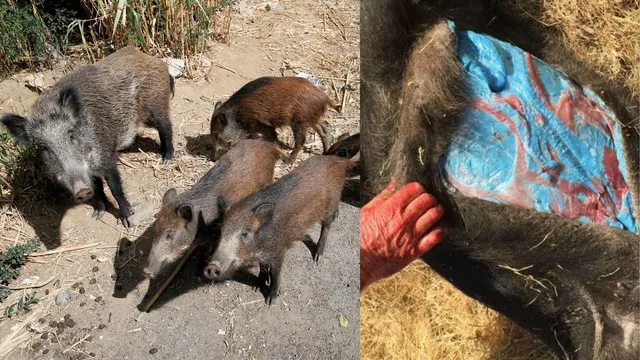- By Supratik Das
- Tue, 19 Aug 2025 02:00 PM (IST)
- Source:JND
In a rare and disturbing case, the flesh of wild pigs in parts of California has been discovered turning a striking neon blue. State authorities have confirmed the cause to be diphacinone, a rodenticide used in agriculture, and have issued a health advisory warning hunters and meat consumers against eating contaminated game.
Reports first emerged from Monterey County, where hunters noticed strange blue pigmentation inside wild pig carcasses. Wildlife control expert Dan Burton, who runs Urban Trapping Wildlife Control in Salinas, told The Los Angeles Times, “I’m not talking about a little blue. I’m talking about neon blue, blueberry blue.” The California Department of Fish and Wildlife (CDFW) later confirmed in an official statement that the discoloration was linked to diphacinone exposure, either through direct ingestion of poisoned bait or by consuming rodents that had eaten it.
Why Pig Flesh Turns Blue?
According to the CDFW, pest-control companies intentionally dye diphacinone pellets a vivid blue to distinguish them from animal feed. Once ingested, the chemical accumulates in tissue and organs, leaving the unusual blue traces visible in fat and muscle. Diphacinone, introduced in the 1960s, is a first-generation anticoagulant. It prevents clotting, eventually causing internal bleeding and death in target species such as rats, ground squirrels and mice.
California imposed stricter limits on diphacinone in 2024. The chemical is now allowed only in highly specific cases, such as mosquito vector control or safeguarding endangered species. Despite the restrictions, wildlife experts remain concerned. “Rodenticide exposure can be a concern for non-target wildlife in areas where applications occur in close proximity to natural habitat,” Dr. Bourbour said in the CDFW statement.
Could Eating It Be Deadly?
CDFW’s Dr. Ryan Bourbour, Pesticide Investigations Coordinator, said in the advisory:, “Hunters should be aware that the meat of game animals such as wild pig, deer, bear and geese might be contaminated if that game animal has been exposed to rodenticides.” Speaking to National Geographic, toxicologists noted that cooking does not neutralize diphacinone. If contaminated meat is consumed, it may lead to serious health problems such as nosebleeds, gum bleeding, blood in urine, bloody stools, abdominal pain, dizziness, low blood pressure and shortness of breath. In severe cases, experts warned, the poisoning could be fatal. Wildlife conservationists warn that diphacinone and other chemical pesticides have devastating ripple effects on ecosystems. Predators, scavengers, and even insects suffer secondary poisoning when exposed to tainted prey. Long-term exposure has also been linked to declining sperm rates, diabetes, and various cancers in humans.
Broader Ecological Risks
This is not the first such incident. In 2015, hunters in Morgan Hill, California, found pigs with fluorescent blue fat inside their bodies. Local reports quoted one hunter as saying: “Everything else about the pig was normal, the meat, blood, etc. The only weird part was the blue fat throughout the body.” A 2018 CDFW study further revealed that 8.3 per cent of wild pigs tested in California showed traces of anticoagulant rodenticides, underlining the extent of the problem.
ALSO READ: Why America's Getting Sicker: Bad Food, Too Many Meds, And Skipping Exercise | DETAILS
Environmental scientists speaking to National Geographic warned that the ripple effects of rodenticide use extend across ecosystems. Owls, mountain lions, condors, bears and even bees have been reported to suffer from secondary poisoning. Wildlife groups have urged a shift toward integrated pest management, relying on natural predators, traps and barriers instead of chemical baits.
ALSO READ: What Is Legionnaires’ Disease? NYC Reports 2 Deaths And Dozens Sick In Harlem Cluster
The CDFW urged hunters and residents to report cases of unusual tissue discoloration, particularly bright blue, to its Wildlife Health Laboratory via email at WHLab@wildlife.ca.gov or phone at (916) 358-2790. In its public warning, the agency stated, “Any game meat showing abnormal blue pigmentation should not be consumed under any circumstances. Even when cooked, diphacinone residues remain active and pose a danger to both humans and wildlife.” As California tightens restrictions on diphacinone, authorities hope that increased vigilance and public awareness will prevent further risks to both wildlife and humans.

